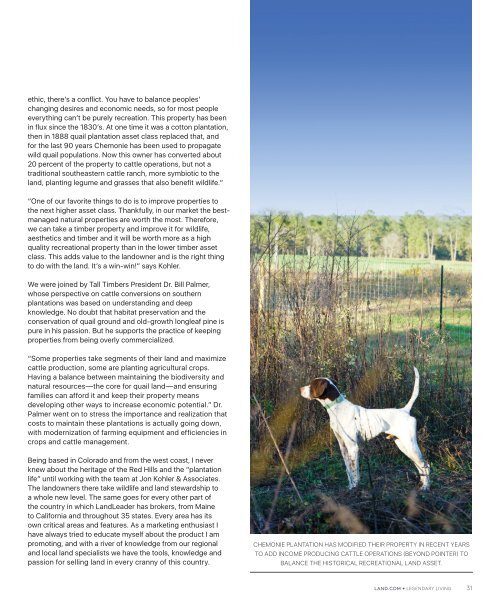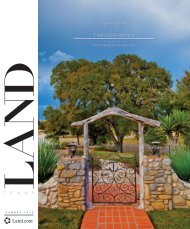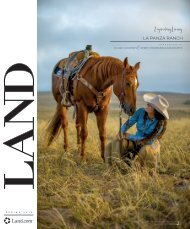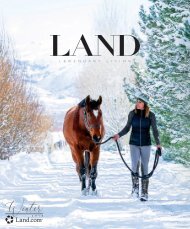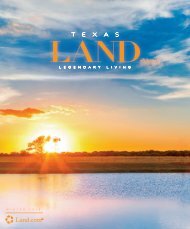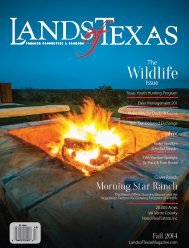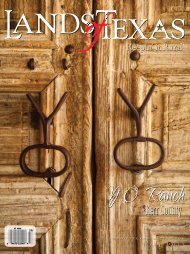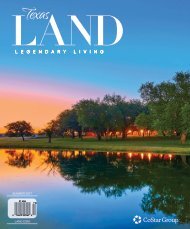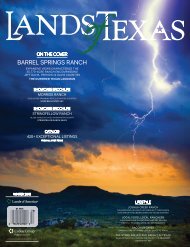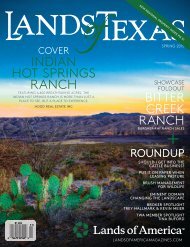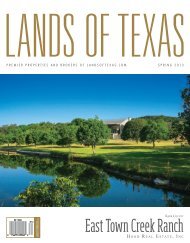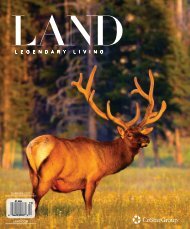•Spring 2017
•Spring 2017
•Spring 2017
Create successful ePaper yourself
Turn your PDF publications into a flip-book with our unique Google optimized e-Paper software.
ethic, there’s a conflict. You have to balance peoples’<br />
changing desires and economic needs, so for most people<br />
everything can’t be purely recreation. This property has been<br />
in flux since the 1830’s. At one time it was a cotton plantation,<br />
then in 1888 quail plantation asset class replaced that, and<br />
for the last 90 years Chemonie has been used to propagate<br />
wild quail populations. Now this owner has converted about<br />
20 percent of the property to cattle operations, but not a<br />
traditional southeastern cattle ranch, more symbiotic to the<br />
land, planting legume and grasses that also benefit wildlife.”<br />
“One of our favorite things to do is to improve properties to<br />
the next higher asset class. Thankfully, in our market the bestmanaged<br />
natural properties are worth the most. Therefore,<br />
we can take a timber property and improve it for wildlife,<br />
aesthetics and timber and it will be worth more as a high<br />
quality recreational property than in the lower timber asset<br />
class. This adds value to the landowner and is the right thing<br />
to do with the land. It’s a win-win!” says Kohler.<br />
We were joined by Tall Timbers President Dr. Bill Palmer,<br />
whose perspective on cattle conversions on southern<br />
plantations was based on understanding and deep<br />
knowledge. No doubt that habitat preservation and the<br />
conservation of quail ground and old-growth longleaf pine is<br />
pure in his passion. But he supports the practice of keeping<br />
properties from being overly commercialized.<br />
“Some properties take segments of their land and maximize<br />
cattle production, some are planting agricultural crops.<br />
Having a balance between maintaining the biodiversity and<br />
natural resources—the core for quail land—and ensuring<br />
families can afford it and keep their property means<br />
developing other ways to increase economic potential.” Dr.<br />
Palmer went on to stress the importance and realization that<br />
costs to maintain these plantations is actually going down,<br />
with modernization of farming equipment and efficiencies in<br />
crops and cattle management.<br />
Being based in Colorado and from the west coast, I never<br />
knew about the heritage of the Red Hills and the “plantation<br />
life” until working with the team at Jon Kohler & Associates.<br />
The landowners there take wildlife and land stewardship to<br />
a whole new level. The same goes for every other part of<br />
the country in which LandLeader has brokers, from Maine<br />
to California and throughout 35 states. Every area has its<br />
own critical areas and features. As a marketing enthusiast I<br />
have always tried to educate myself about the product I am<br />
promoting, and with a river of knowledge from our regional<br />
and local land specialists we have the tools, knowledge and<br />
passion for selling land in every cranny of this country.<br />
CHEMONIE PLANTATION HAS MODIFIED THEIR PROPERTY IN RECENT YEARS<br />
TO ADD INCOME PRODUCING CATTLE OPERATIONS (BEYOND POINTER) TO<br />
BALANCE THE HISTORICAL RECREATIONAL LAND ASSET.<br />
LAND.COM • LEGENDARY LIVING<br />
31


